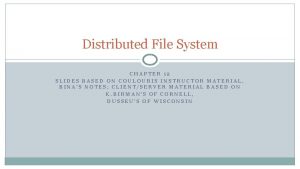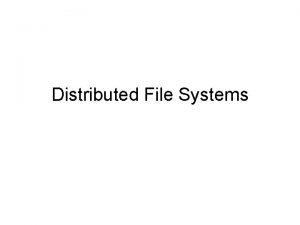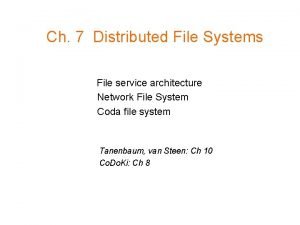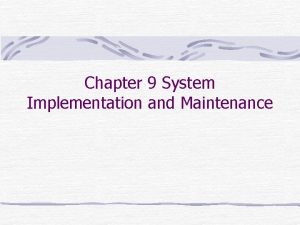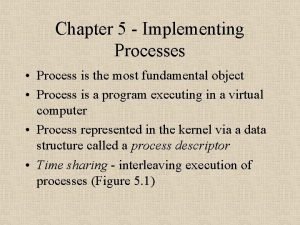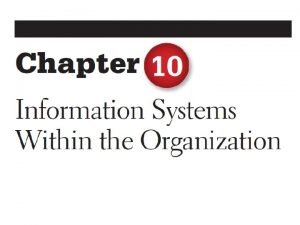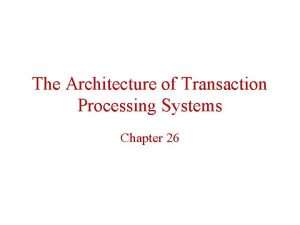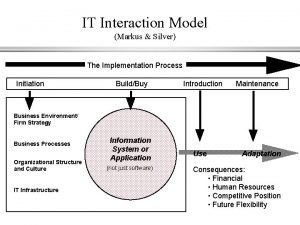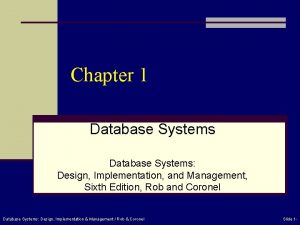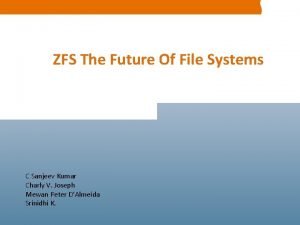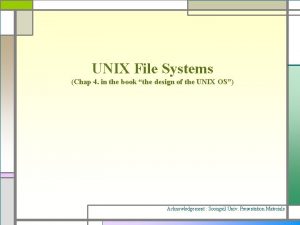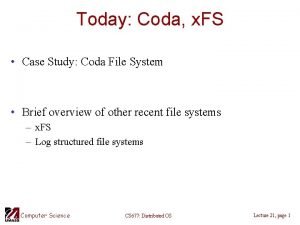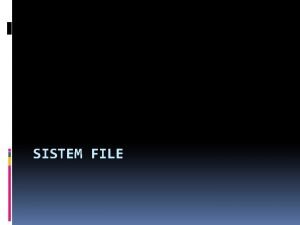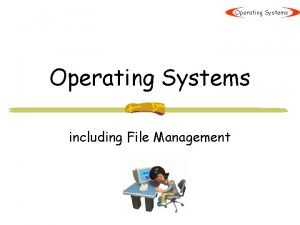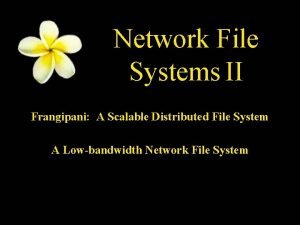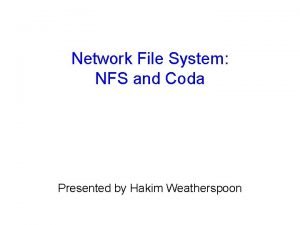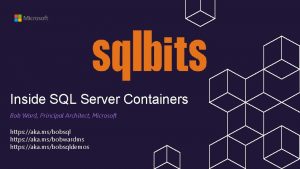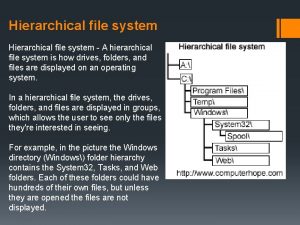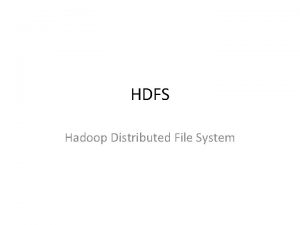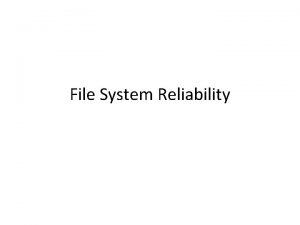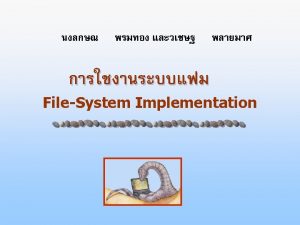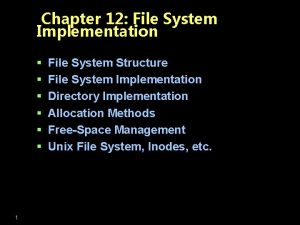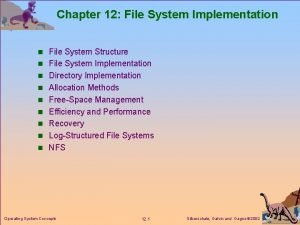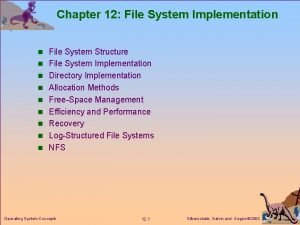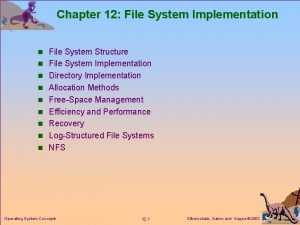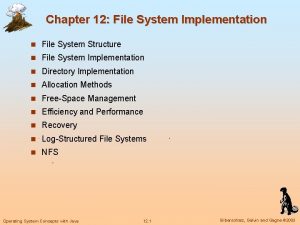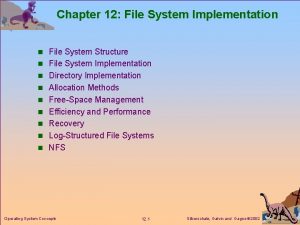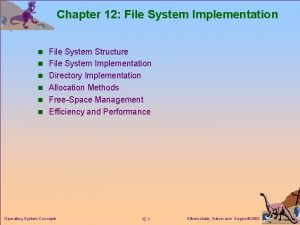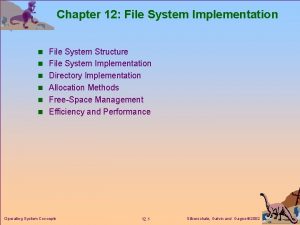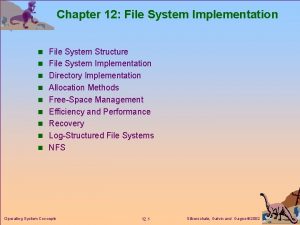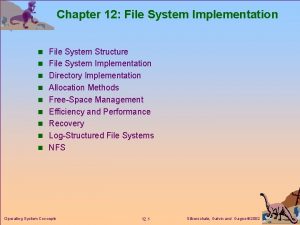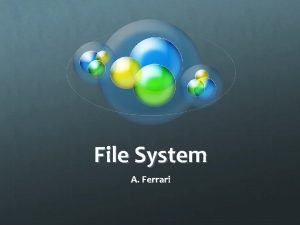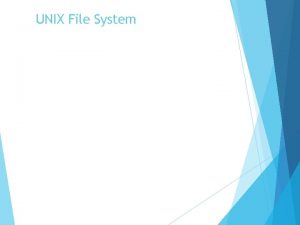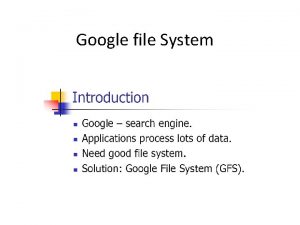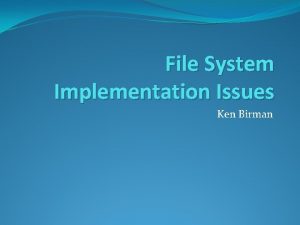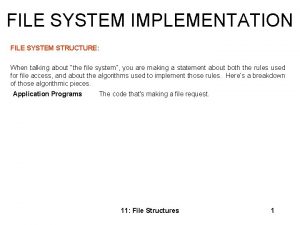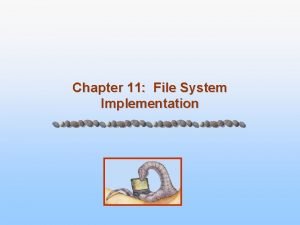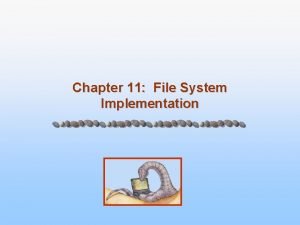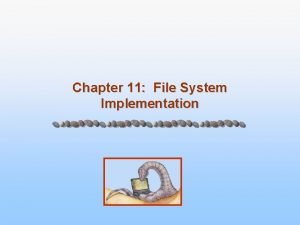Chapter 11 File System Implementation Chapter 11 File




















![Free-Space Management n Bit vector (n blocks) 0 1 2 n-1 … bit[i] = Free-Space Management n Bit vector (n blocks) 0 1 2 n-1 … bit[i] =](https://slidetodoc.com/presentation_image_h/b59959da0a9a004c417580a4352c3865/image-21.jpg)





















- Slides: 42

Chapter 11: File System Implementation

Chapter 11: File System Implementation n File-System Structure n File-System Implementation n Directory Implementation n Allocation Methods n Free-Space Management n Efficiency and Performance n Recovery n Log-Structured File Systems n NFS n Example: WAFL File System

File-System Structure n File structure l Logical storage unit l Collection of related information n File system resides on secondary storage (disks) n File system organized into layers n File control block – storage structure consisting of information about a file

Layered File System

A Typical File Control Block

In-Memory File System Structures n The following figure illustrates the necessary file system structures provided by the operating systems. n Figure 12 -3(a) refers to opening a file. n Figure 12 -3(b) refers to reading a file.

In-Memory File System Structures

Virtual File Systems n Virtual File Systems (VFS) provide an object-oriented way of implementing file systems. n VFS allows the same system call interface (the API) to be used for different types of file systems. n The API is to the VFS interface, rather than any specific type of file system.

Schematic View of Virtual File System

Directory Implementation n Linear list of file names with pointer to the data blocks. l simple to program l time-consuming to execute n Hash Table – linear list with hash data structure. l hash table takes a value computed from file name and returns a pointer to the file name in a linear list l decreases directory search time l collisions – situations where two file names hash to the same location l fixed size

Allocation Methods n An allocation method refers to how disk blocks are allocated for files: n Contiguous allocation n Linked allocation n Indexed allocation

Contiguous Allocation n Each file occupies a set of contiguous blocks on the disk n Simple – only starting location (block #) and length (number of blocks) are required n Random access n Wasteful of space (dynamic storage-allocation problem: how to satisfy request from list of non-contiguous free holes) n Files cannot grow

Contiguous Allocation of Disk Space

Linked Allocation n Each file is a linked list of disk blocks: blocks may be scattered anywhere on the disk. n Directory contains pointer to the first and last blocks of the file. n Variation: l File-allocation table (FAT) – disk-space allocation used by MS-DOS and OS/2.

Linked Allocation

File-Allocation Table

Indexed Allocation n Brings all pointers together into the index block. n Logical view. index table n Each file has its own index block

Example of Indexed Allocation

Indexed Allocation – Mapping (Cont. ) outer-index table file

Combined Scheme: UNIX (4 K bytes per block)
![FreeSpace Management n Bit vector n blocks 0 1 2 n1 biti Free-Space Management n Bit vector (n blocks) 0 1 2 n-1 … bit[i] =](https://slidetodoc.com/presentation_image_h/b59959da0a9a004c417580a4352c3865/image-21.jpg)
Free-Space Management n Bit vector (n blocks) 0 1 2 n-1 … bit[i] = 0 block[i] free 1 block[i] occupied Block number calculation (number of bits per word) * (number of 0 -value words) + offset of first 1 bit

Free-Space Management (Cont. ) n Bit map requires extra space l Example: block size = 212 bytes disk size = 230 bytes (1 gigabyte) n = 230/212 = 218 bits (or 32 K bytes) n Easy to get contiguous files n Linked list (free list) l Cannot get contiguous space easily l No waste of space n Grouping n Counting

Free-Space Management (Cont. ) n Need to protect: Pointer to free list l Bit map 4 Must be kept on disk 4 Copy in memory and disk may differ 4 Cannot allow for block[i] to have a situation where bit[i] = 1 in memory and bit[i] = 0 on disk l Solution: 4 Set bit[i] = 1 in disk 4 Allocate block[i] l 4 Set bit[i] = 1 in memory

Directory Implementation n Linear list of file names with pointer to the data blocks l simple to program l time-consuming to execute n Hash Table – linear list with hash data structure l decreases directory search time l collisions – situations where two file names hash to the same location l fixed size

Linked Free Space List on Disk

Efficiency and Performance n Efficiency dependent on: l disk allocation and directory algorithms l types of data kept in file’s directory entry n Performance l disk cache – separate section of main memory for frequently used blocks l free-behind and read-ahead – techniques to optimize sequential access l improve PC performance by dedicating section of memory as virtual disk, or RAM disk

Page Cache n A page caches pages rather than disk blocks using virtual memory techniques n Memory-mapped I/O uses a page cache n Routine I/O through the file system uses the buffer (disk) cache n This leads to the following figure

I/O Without a Unified Buffer Cache

Recovery n Consistency checking – compares data in directory structure with data blocks on disk, and tries to fix inconsistencies n Use system programs to back up data from disk to another storage device (floppy disk, magnetic tape, other magnetic disk, optical) n Recover lost file or disk by restoring data from backup

Log Structured File Systems n Log structured (or journaling) file systems record each update to the file system as a transaction n All transactions are written to a log l A transaction is considered committed once it is written to the log l However, the file system may not yet be updated n The transactions in the log are asynchronously written to the file system l When the file system is modified, the transaction is removed from the log n If the file system crashes, all remaining transactions in the log must still be performed

The Sun Network File System (NFS) n An implementation and a specification of a software system for accessing remote files across LANs (or WANs) n The implementation is part of the Solaris and Sun. OS operating systems running on Sun workstations using an unreliable datagram protocol (UDP/IP protocol and Ethernet

NFS (Cont. ) n Interconnected workstations viewed as a set of independent machines with independent file systems, which allows sharing among these file systems in a transparent manner l A remote directory is mounted over a local file system directory 4 The mounted directory looks like an integral subtree of the local file system, replacing the subtree descending from the local directory l Specification of the remote directory for the mount operation is nontransparent; the host name of the remote directory has to be provided 4 Files in the remote directory can then be accessed in a transparent manner l Subject to access-rights accreditation, potentially any file system (or directory within a file system), can be mounted remotely on top of any local directory

NFS (Cont. ) n NFS is designed to operate in a heterogeneous environment of different machines, operating systems, and network architectures; the NFS specifications independent of these media n This independence is achieved through the use of RPC primitives built on top of an External Data Representation (XDR) protocol used between two implementation-independent interfaces n The NFS specification distinguishes between the services provided by a mount mechanism and the actual remote-file-access services

NFS Protocol n Provides a set of remote procedure calls for remote file operations. The procedures support the following operations: l searching for a file within a directory l reading a set of directory entries l manipulating links and directories l accessing file attributes l reading and writing files n NFS servers are stateless; each request has to provide a full set of arguments (NFS V 4 is just coming available – very different, stateful) n Modified data must be committed to the server’s disk before results are returned to the client (lose advantages of caching) n The NFS protocol does not provide concurrency-control mechanisms

Three Major Layers of NFS Architecture n UNIX file-system interface (based on the open, read, write, and close calls, and file descriptors) n Virtual File System (VFS) layer – distinguishes local files from remote ones, and local files are further distinguished according to their file-system types l The VFS activates file-system-specific operations to handle local requests according to their file-system types l Calls the NFS protocol procedures for remote requests n NFS service layer – bottom layer of the architecture l Implements the NFS protocol

Schematic View of NFS Architecture

NFS Path-Name Translation n Performed by breaking the path into component names and performing a separate NFS lookup call for every pair of component name and directory vnode n To make lookup faster, a directory name lookup cache on the client’s side holds the vnodes for remote directory names

NFS Remote Operations n Nearly one-to-one correspondence between regular UNIX system calls and the NFS protocol RPCs (except opening and closing files) n NFS adheres to the remote-service paradigm, but employs buffering and caching techniques for the sake of performance n File-blocks cache – when a file is opened, the kernel checks with the remote server whether to fetch or revalidate the cached attributes l Cached file blocks are used only if the corresponding cached attributes are up to date n File-attribute cache – the attribute cache is updated whenever new attributes arrive from the server n Clients do not free delayed-write blocks until the server confirms that the data have been written to disk

Example: WAFL File System n Used on Network Appliance “Filers” – distributed file system appliances n “Write-anywhere file layout” n Serves up NFS, CIFS, http, ftp n Random I/O optimized, write optimized l NVRAM for write caching n Similar to Berkeley Fast File System, with extensive modifications

The WAFL File Layout

Snapshots in WAFL

11. 02
 Distributed file system notes
Distributed file system notes File-file yang dibuat oleh user pada jenis file di linux
File-file yang dibuat oleh user pada jenis file di linux Remote file access in distributed file system
Remote file access in distributed file system In a file-oriented information system, a transaction file
In a file-oriented information system, a transaction file File system modules in distributed system
File system modules in distributed system Distributed file system architecture
Distributed file system architecture File system in operating system
File system in operating system File system in operating system
File system in operating system File system in operating system
File system in operating system System implementation and maintenance
System implementation and maintenance Implementation of process in operating system
Implementation of process in operating system System implementation and operation
System implementation and operation A transaction is any business event that generates
A transaction is any business event that generates Rpc implementation in distributed system
Rpc implementation in distributed system What is system construction
What is system construction Define the eight stages of the sdlc
Define the eight stages of the sdlc Cse 132
Cse 132 Rpc implementation in distributed system
Rpc implementation in distributed system It interaction model
It interaction model Database systems: design, implementation, and management
Database systems: design, implementation, and management Nachiket acharya
Nachiket acharya Job order contracting (joc) system implementation
Job order contracting (joc) system implementation Database systems design implementation
Database systems design implementation Physical image vs logical image
Physical image vs logical image File sharing management system
File sharing management system An html file is a text file containing small markup tags
An html file is a text file containing small markup tags Chapter 6 implementation and evaluation
Chapter 6 implementation and evaluation Is earth a closed system or open system
Is earth a closed system or open system Site:slidetodoc.com
Site:slidetodoc.com Writable volumes
Writable volumes Namei algorithm in unix
Namei algorithm in unix Coda x**
Coda x** Sistem file
Sistem file File management operating system
File management operating system Nfs architecture
Nfs architecture Frangipani: a scalable distributed file system
Frangipani: a scalable distributed file system Afs vs nfs
Afs vs nfs Berikut ini yang bukan sasaran dari file sistem adalah
Berikut ini yang bukan sasaran dari file sistem adalah File processing system
File processing system Aka.ms/k8slearning
Aka.ms/k8slearning What is hierarchical file system
What is hierarchical file system Hadoop distributed file system
Hadoop distributed file system File system reliability
File system reliability
